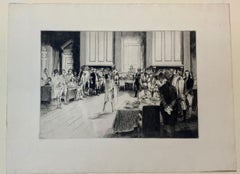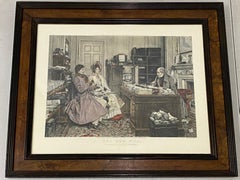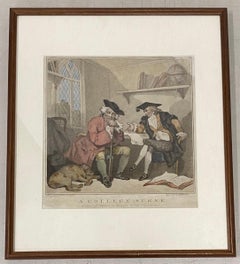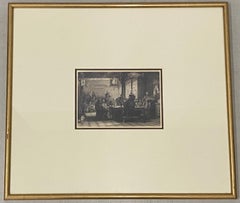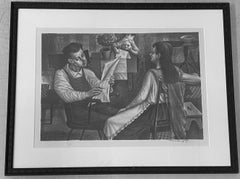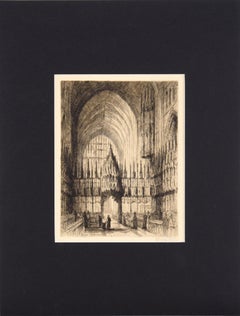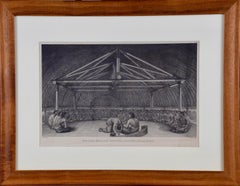Quintessential Things Interior Prints
to
5
1
Overall Width
to
Overall Height
to
1
1
2
3
1
1
5
1
6
3
2
1
1
1
1
1
1
3
1
1
1
5
6
Picasso at Vauvenargues 1962 by David Douglas Duncan
Located in San Francisco, CA
David Douglas Duncan: 1916-2018. Well listed photographer who had rare access to Picasso. He took numerous photos of the master at work, and at pl...
Category
1960s Figurative Photography
Materials
Offset
John Winkler "The Constitutional Convention" Original Signed Etching c.1932
Located in San Francisco, CA
John Winkler "The Constitutional Convention" Original Signed Etching c.1932
Plate dimensions 13.75" wide x 9.5" high
Paper dimensions 19.75" wide x 14....
Category
Early 20th Century Interior Prints
Materials
Etching
James Dobie "The New Will" Color Engraving After Walter Dendy Sadler c.1894
Located in San Francisco, CA
James Dobie "The New Will" Color Engraving After Walter Dendy Sadler c.1894
Original 19th century color engraving
Engraved by James Dobie after artwork b...
Category
Late 19th Century Interior Prints
Materials
Engraving
Edward Williams "A College Scene" After Thomas Rowlandson Color Engraving C.1787
By Thomas Rowlandson
Located in San Francisco, CA
Edward Williams "A College Scene" After Thomas Rowlandson Color Engraving C.1787
Late 18th century hand colored engraving after Thomas Rowlandson
A scene of a young student asking ...
Category
Late 18th Century Figurative Prints
Materials
Engraving
G. Paterson "Dinner Party at a Mandarin's House" Engraving After T. Allom c.1840
Located in San Francisco, CA
G. Paterson "Dinner Party at a Mandarin's House" Original Engraving After T. Allom C.1840
Original engraving
Dimensions 8" wide x 5" high
The frame measures 20.5" wide x 18.5" hig...
Category
Mid-19th Century Realist Interior Prints
Materials
Engraving
Ture Bengtz "Family Scene" Original Pencil Signed Lithograph C.1940
By Ture Bengtz
Located in San Francisco, CA
Ture Bengtz "Family Scene" Original Pencil Signed Lithograph C.1940
Lithograph dimensions 15.25" wide x 10.5" high
Frame dimensions 21.5" wide x 17" high
Pencil signed in the lowe...
Category
Early 20th Century Figurative Prints
Materials
Lithograph
Related Items
Chester Cathedral - Drypoint Etching in Ink on Paper
Located in Soquel, CA
Chester Cathedral - Drypoint Etching in Ink on Paper
Dramatic drypoint etching by J. Alphege Brewer (British, 1881-1946). This composition shows the interior of Chester Cathedral in Brewer's characteristic style - highly detailed and with strong contrast. The scene encompasses the cathedral from floor to ceiling, capturing the immense size of the building. There are several people in the scene which contribute to the sense of scale.
Signed by hand "J. Alphege Brewer" in the lower right corner.
Titled "Chester Cathedral" in plate, lower left corner.
Includes original card with artist's name.
Presented in a new black mat with foamcore backing.
Mat size: 16"H x 12"W
Paper size: 10.75"H x 7.75"W
James Alphege Brewer was well known in the early 20th century as a producer of color etchings of European cathedrals and other scenes of church, college, and community. He was born July 24, 1881, in the Kensington section of London, England, the son of Henry W. Brewer, noted artist of historical architecture and prominent convert to the Catholic Church, and the grandson of John Sherren Brewer, Jr., “the brilliant editor of the Calendar of Letters of Henry VIII.” His great uncle was E. Cobham Brewer, the polymath who compiled Brewer’s Dictionary of Phrase and Fable. Among his older siblings were the artist Henry C. Brewer and the organist and writer John Francis Brewer.
Brewer attended the Westminster School of Art in London, where his brother Henry also trained. In 1910, he married Florence Emma Lucas, an accomplished painter in oil and watercolor, whose father was the noted landscape artist George Lucas and whose great uncle was David Lucas, the famous engraver for John Constable. Florence's brothers Edwin and George assisted Brewer in the printing of Brewer's etchings.
Brewer exhibited at the Royal Academy (RA) and the Royal Institute of Painters in Watercolour (RI), at the Paris Salon of the Académie des Beaux-Arts, and in the shows of the Royal Cambrian Academy (RCA). He became an associate of the Royal Cambrian Academy in 1929 and a full member in the last two years of his life. He was also a member of the Hampstead Society of Artists, the Society of Graphic Art, and the Ealing Arts Club, where he was first Honorary Art Secretary and then Honorary Art Chairman. Most of Brewer's larger etchings were published by Alfred Bell...
Category
Early 20th Century Romantic Interior Prints
Materials
Paper, Ink, Drypoint
$495
H 16 in W 12 in D 0.25 in
"King of the Friendly Islands" (Tonga); Engraving from Captain Cook's 3rd Voyage
By John Webber
Located in Alamo, CA
"Poulaho, King of the Friendly Islands, Drinking Kava" is an engraving created by William Sharp (1749-1824), from a drawing by John Webber (1752-1793), who was the artist on Captain James Cook's 3rd and final voyage of discovery. It was published in the atlas of "A Voyage to the Pacific Ocean Undertaken by the Command of His Majesty, for Making Discoveries in the Northern Hemisphere", the official British Admirality sanctioned journal published upon completion of the voyage in London in 1784 by Strahan & Cadell.
Captain Cook visited Tonga on his 3rd voyage, which he named The Friendly Islands because of the warm welcome he and his crew received, unlike some of the other more hostile Pacific islands. The engraving depicts Cook and his men observed a kava ceremony at the village of Mu’a on Tongatapu. King Paulaho sits in the centre foreground, his back to the spectator with a man kneeling before him. The ceremonial mat depicted behind Paulaho indicates that nobody was allowed to sit behind him. The figure in the centre holds a single cup, referring to the Tongan custom of offering the cup to the king first. Kava is native to the islands of the South Pacific and was first described for English readers in 1768 by Captain James Cook. The kava root has been used for centuries as a central feature of ceremonies and celebrations because it was able to bring about a calming and pleasant social atmosphere. The root was crushed and processed into coconut milk to become the focal ceremonial beverage, simply referred to as kava.
This engraving is presented in a Koa wood frame and a white mat. Koa wood is legendary in Hawaii. There are occasional faint spots, but the print is otherwise in very good condition. This amazing Koa wood is native to Hawaii and it is known for the deep rich colors and varied grain pattern. Koa has an honored heritage in Hawaii and is highly revered and sacred. The word “koa” means “warrior” in Hawaiian. The warriors of King Kamehameha the Great, created canoes and weapons from a wood plentiful on the Big Island of Hawaii. This wood became synonymous with the warriors themselves, and it became known as koa.
There are three other engravings listed from the official journal of Captain Cook's 3rd voyage available that are presented in identical Koa wood frames and mats (LU117324682422, LU117324684052, LU117324684032). They would make a wonderful grouping for a display of 2, 3 or 4 prints. A discount is available for a grouping depending on the number of items included.
Captain Cook is remembered as one of the greatest explorers and navigators in history. His explorations included Australia, New Zealand and islands of the South Pacific and the northwest coast of North America. Hawaii was discovered by Captain Cook during this voyage. Hawaii was originally called The Sandwich Islands in honor of The Earl of Sandwich...
Category
1780s Realist Figurative Prints
Materials
Engraving
$2,375
H 18.25 in W 23.5 in D 0.88 in
Don Juan
By Louis Icart
Located in Missouri, MO
Aquating Engraving
Image Size: approx. 20 1/4 x 13 3/8
Framed Size: 28 x 20.5 inches
Pencil Signed Lower Right
Louis Justin Laurent Icart was born in Toulouse in 1890 and died in Paris in 1950. He lived in New York City in the 1920s, where he became known for his Art-Deco color etchings of glamourous women.
He was first son of Jean and Elisabeth Icart and was officially named Louis Justin Laurent Icart. The use of his initials L.I. would be sufficient in this household. Therefore, from the moment of his birth he was dubbed 'Helli'. The Icart family lived modestly in a small brick home on rue Traversière-de-la-balance, in the culturally rich Southern French city of Toulouse, which was the home of many prominent writers and artists, the most famous being Henri de Toulouse-Lautrec.
Icart entered the l'Ecole Superieure de Commerce de Toulouse in order to continue his studies for a career in business, particularly banking (his father's profession). However, he soon discovered the play writings of Victor Hugo (1802-1885), which were to change the course of his life. Icart borrowed whatever books he could find by Hugo at the Toulouse library, devouring the tales, rich in both romantic imagery and the dilemmas of the human condition. It was through Icart's love of the theater that he developed a taste for all the arts, though the urge to paint was not as yet as strong for him as the urge to act.
It was not until his move to Paris in 1907 that Icart would concentrate on painting, drawing and the production of countless beautiful etchings, which have served (more than the other mediums) to indelibly preserve his name in twentieth century art history.
Art Deco, a term coined at the 1925 Paris Exposition des Arts Decoratifs, had taken its grip on the Paris of the 1920s. By the late 1920s Icart, working for both publications and major fashion and design studios, had become very successful, both artistically and financially. His etchings reached their height of brilliance in this era of Art Deco, and Icart had become the symbol of the epoch. Yet, although Icart has created for us a picture of Paris and New York life in the 1920s and 1930s, he worked in his own style, derived principally from the study of eighteenth-century French masters such as Jean Antoine Watteau, François Boucher and Jean Honoré Fragonard.
In Icart's drawings, one sees the Impressionists Degas...
Category
1920s Art Deco Figurative Prints
Materials
Engraving, Aquatint
THE LAMP Vintage Lithograph Poster, 1st Printing 1984, Civil Rights, Justice
By Romare Bearden
Located in Union City, NJ
ROMARE BEARDEN 1970-1980
THE LAMP (after the 1984 collage on board by Bearden)
Vintage 1984 Commemorative Poster - Brown v. Board of Education 30 Years later: "The Politics of Excel...
Category
1980s Contemporary Portrait Prints
Materials
Offset
$316 Sale Price
20% Off
H 33.75 in W 21.5 in
Kabuki actor Nakamura Shikan II by Utagawa Kunisada Edo Japanese Woodblock Print
By Utagawa Kunisada (Toyokuni III)
Located in Soquel, CA
Kabuki actor Nakamura Shikan II by Utagawa Kunisada Japanese Woodblock Print
Wonderful portrait of Nakamura Shikan II, a prominent kabuki actor, in the role of Kisen Hoshi Toyokuni ...
Category
1820s Realist Figurative Prints
Materials
Printer's Ink, Rice Paper, Woodcut
$357 Sale Price
35% Off
H 21.75 in W 16.75 in D 1.25 in
'Jesus and the Woman at the Well, ' by Amand-Durand, Engraving
By Armand Durand
Located in Oklahoma City, OK
This early 19th century framed 35" x 31" engraving by artist Amand-Durand depcits an etching of 'Jesus and the Woman at the Well,' after the Dutch master, Rembrandt van Rijn. This poignant Biblical story is depicted by Arman-Durand in Rembrandt style...
Category
Early 19th Century Old Masters Figurative Prints
Materials
Engraving
$1,200 Sale Price
20% Off
H 30.5 in W 26.5 in D 1.5 in
Vin Rouge (Red Wine)
By Edmund Blampied
Located in Storrs, CT
1932. Drypoint. Appleby 167. 9 1/4 x 11 5/8 (sheet 11 3/8 x 17 15/16). Edition 100 #48. Mat line, well outside the image; otherwise excellent condition. A rich impression with drypo...
Category
1930s Modern Interior Prints
Materials
Drypoint
Ethel Katz, Fur Sources, New Deal-era lithograph of sweatshop
Located in New York, NY
This is a classic New-Deal image: claustrophobic sweatshop with a row of hunched tailors. The windows and lamps offer light at least. But there is a major difference between this and...
Category
1930s American Modern Figurative Prints
Materials
Lithograph
$675
H 10.38 in W 15.5 in
Original AJANTA INDIA Bodhisattva Padmapani vintage travel poster 1959
Located in Spokane, WA
Original Ajanta India vintage travel poster from 1959. Archival linen backed in Grade A condition, ready to frame. Note that a later edition of this poster was printed but the im...
Category
1950s Old Masters Figurative Prints
Materials
Lithograph
$995
H 39.5 in W 24.25 in D 0.3 in
HAMBURGER KNIEPPE
By Käthe Kollwitz
Located in Santa Monica, CA
KATHE KOLLWITZ (1867-1945)
HAMBURGER KNIEPPE, 1901) (K.58 IIIb)
Soft Ground Etching, Plate 9 ¾ x 8 ¼ sheet 10 ½ x 13 ¾. With the von de Becke blind stamp in the lower right. Prin...
Category
Early 1900s Expressionist Interior Prints
Materials
Etching
Fireside Christmas
Located in San Francisco, CA
This artwork titled "Fireside Christmas" c. 1985 is an original color etching by American artist Scott Fitzgerald. It is hand signed, titled and numbered 158/250 in pencil by the artist. Published and printed by the artist. The image (plate mark) size is 11.5 x 17.65 inches, sheet size is 19.25 x 25.25 inches. it is in excellent condition, has never been framed.
About the artist:
Scott Fitzgerald received his Master’s Degree in Arts from California State University Fullerton, and went on to teach drawing and printmaking for 2 years at the university.
During his college years, he focused his study in contemporary art and photography, creating mixed media works often with social comments. It was not until the sophomore year, he discovered the traditional art of etching in his printmaking class. Immediately, he embraced the complex and difficult technical process of making prints from etching on copper plates.
Scott Fitzgerald established himself as a prominent printmaker in the next few years. With a strong interest in history, he accepted a commission to produce a series of etching depicting 15 Orange County historical landmarks. Besides producing very intricate prints in various sizes, he has engaged in many special projects. He worked with renowned English printer John Randle to produce a group of etchings...
Category
Late 20th Century American Realist Figurative Prints
Materials
Etching
William B. Sharp, The Wedding, 1946, lithograph
Located in New York, NY
William Bertrum Sharp (1924-1984) served in the Armed Forces during World War II and is considered among the first artists to attend art school under the GI Bill.
He studied (proba...
Category
1940s American Modern Figurative Prints
Materials
Lithograph
